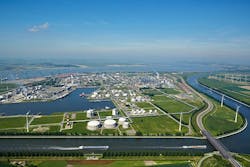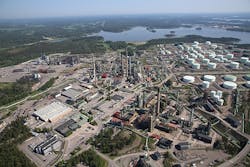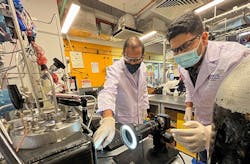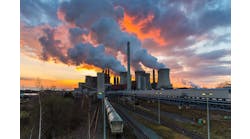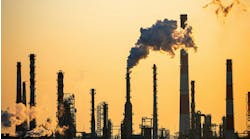Environmental Protection: Collaboration Promises A Winning Hand
As industry and society as a whole place increasing emphasis on carbon neutrality, i.e., net-zero carbon emissions, the successful development and deployment of carbon capture and utilization (CCU), carbon capture and storage (CCS), and carbon capture, utilization and storage (CCUS) technologies will underpin the complex projects necessary to reach that goal. Many of these projects involve extensive collaboration by companies and governments, as initiatives that include BASF, Air Liquide, Neste, Perstorp and others show. (Last month’s cover story “Net Zero Efforts Add Up,” looked at carbon-reduction projects of some individual chemical makers.)
One of the world’s most ambitious projects involves the coming together of BASF, Ludwigshafen, Germany; Air Liquide, Paris; the European Union (E.U.); and both the Belgian federal government and that of the country’s Flemish region.
Together, the two companies are committed to developing the world’s largest cross-border CCS value chain at the industrial cluster in the port of Antwerp, Belgium.
Known as the Kairos@C project, it aims to optimize and integrate carbon dioxide capture and purification at five different production plants — two for hydrogen, two for ethylene oxide, and one for ammonia — at BASF’s Antwerp complex (Figure 1).
The project has been made possible by €357 million (≈$390 million) in funding from the €1.1 billion (≈$1.2 billion) E.U. Innovation Fund; it is one of seven large-scale projects selected at the end of last year from more than 300 applications.
To remove the CO2 from these plants, the companies plan to combine Air Liquide’s Cryocap CO2 capture technology with BASF’s Sorbead water-resistant silica-gel adsorbent material. This will be the first time the two companies have worked together with these two technologies, according to a BASF spokesman, who would not divulge any technical details on how they will be integrated.
Figure 1. Carbon-capture-and-purification project will cover five different production units at Antwerp complex. Source: BASF.
“The challenge is especially the scale. The technology is known, but it hasn’t ever been applied at this scale,” he adds, noting that Kairos@C targets reducing CO2 emissions by 1.5 million mt/y.
Start-up currently is planned for the third quarter of 2025. However, this depends both on the Karios@C technologies being in place, and on the necessary compression, liquefaction and export terminal facilities being ready, too, the spokesman explains.
This infrastructure is being built under the framework of Antwerp@C, a consortium that includes founding members Air Liquide and BASF, along with Borealis, ExxonMobil, Fluxys, INEOS, Total, and the Port of Antwerp.
Together, they aim to remove 18.65 million mt/y of greenhouse-gas emissions from the Antwerp complex by 2030.
Antwerp@C already has secured Connecting Europe Facility funding. A feasibility study concluded that a central pipeline “backbone” linking industrial zones on both sides of the River Sheldt with shared processing units, a shared CO2 liquefaction unit, interim storage facilities and cross-border transport of the gas, both by ship and by pipeline, is possible.
“The FEED [front-end engineering design] of this backbone and of the liquefaction terminal is currently being executed,” notes the spokesman.
Other European Projects
Another beneficiary of the E.U. Innovation Fund is Neste, Espoo, Finland. The company has been awarded just over €88 million (≈$96 million) for a green hydrogen and CO2 CCS project at its Porvoo refinery (Figure 2).
Known as Sustainable Hydrogen and Recovery of Carbon (SHARC) project, it will reduce emissions from the plant by moving it from grey hydrogen toward green hydrogen through the introduction of electrolysis facilities, and blue hydrogen by application of CCS. (Because hydrogen is essential in the making of transportation fuels, this green and blue hydrogen will decrease the carbon intensity of the fuels produced.) SHARC also will scale the production of green hydrogen to help make it a viable transportation fuel itself.
The first ten years of the project’s operation should capture four million mt of CO2.
Figure 2. E. U. funding will support a green hydrogen and CO2 CCS project at Porvoo site. Source: Neste.
The novel water-electrolysis technology applied by SHARC has a capacity of 50 MW, according to the company’s funding application. This, combined with CCS, will maximize the benefits to the environment and the development of a strong supply chain from the refinery, by ship to storage site, and will lay the foundation for a European hub for renewable hydrogen and CO2 utilization.
“Neste hosted a grant signing ceremony on 4 April and the project is currently in the feasibility phase. The target is to start up in the mid-2020s,” says Outi Ervasti, Neste vice president, renewable hydrogen.
While Neste has experience on the use of carbon capture technologies, they will be implemented on a larger scale than ever before by SHARC, she adds. In addition, the company has yet to finalize the details for implementing the novel electrolysis technology.
Neste also is evaluating other in-house projects as potential candidates for future E.U. Innovation Fund applications, she says.
Meanwhile Perstorp, Malmö, Sweden, submitted a modified application to the E.U. Innovation Fund on March 3, the deadline for second bids.
Together with energy company Fortum, Espoo, Finland, and decarbonization specialist Uniper, Dusseldorf, Germany, Perstorp has applied for €97 million (≈$106 million) toward Project Air.
The plan is to create the first-of-its-kind, large-scale, commercial, sustainable methanol plant that uses a CCU process for converting CO2, residue streams, renewable hydrogen and biomethane to methanol. The renewable hydrogen will come from a new electrolysis plant that will be the world’s largest hydrogen electrolysis unit installed for production in the chemical sector, the company says.
The facility, planned for Stenungsund, Sweden, would cost over €236 million (≈$257 million) if it goes ahead. It could be up-and-running by 2026 and reduce CO2 emissions by 400,000 mt/y, equivalent to approximately 1% of those of Sweden overall.
North American Venture
Meanwhile, Svante, Vancouver, B.C., and Kewit Energy Group, Omaha, Neb., have signed a memorandum of understanding to establish a strategic alliance to pursue industrial carbon capture projects in both Canada and the United States.
Known as KSI Alliance, the aim is to offer a one-stop-shop common business development and construction approach from pre-construction services phase to engineering, procurement and construction project delivery.
The projects will employ Svante’s solid sorbent technology to capture CO2 directly from industrial post-combustion diluted flue gases. This will provide a non-intrusive end-of-the-pipe way to produce pipeline-grade pure CO2 for safe storage.
In another development, Svante has announced the successful scale-up of a new sorbent material used in carbon capture processes. Its CALF-20 metal organic framework (MOF) material captures up to 95% of CO2 emitted from industrial sources, using rapid solid adsorption and low temperature steam.
Working with BASF, Svante says it has successfully scaled up manufacture of the MOF to industrial scale using a low temperature process.
In addition, Svante has developed a high-volume and low-cost roll-to-roll process for coating the sorbent onto a laminate sheet. This “sorbent on a roll” then is stacked into a high-performance filter. The company did not respond to queries about whether this filter now is in industrial use.
Meanwhile, various efforts by individual companies and universities on CO2 storage and conversion are underway.
Underground Storage
Many CCS technologies focus on compressing CO2 into a liquid and injecting it underground. However, this strategy poses significant engineering challenges and environmental concerns, with CCS also attracting criticism for being too expensive and energy-intensive for widespread use.
A case in point is Moomba CCS project of natural-gas producer Santos, Adelaide, Australia. The plan is to store 1.7 million mt/y in depleted natural-gas reservoirs in the onshore Cooper Basin in South Australia.
Santos says that carbon capture would serve to reduce emissions from the gas extraction process. Longer-term, the company also hopes to use the technology in the manufacture of blue hydrogen, which extracts hydrogen from natural gas and captures and stores the waste CO2 produced in the process.
According to the Financial Times, Santos has secured a network of depleted gas reservoirs that can hold 100 million mt of CO2, opening up a potentially lucrative line in carbon credits worth as much as A$25 million/y (≈$19 million/y). On the other hand, critics point out that similar CCS schemes in Australia have under-performed and that the strategy would allow Santos to prolong gas production and the associated release of CO2.
Meanwhile, researchers from the Department of Chemical and Biomolecular Engineering at the University of Singapore, Singapore, have come up with an innovative strategy to store CO2 underground. They propose storing the gas in the form of hydrates under ocean floor sediments; natural pressure created by the weight of the seawater above would keep the hydrates in place. The conditions there, typically 2–6°C and 100 atm, enable the CO2 hydrates to store nearly 200 times their own volume of the gas.
The researchers say not only is this approach viable but also the existence in nature of huge volumes of methane hydrates in ocean-floor locations around the world offers an encouraging analogy about the stability and safety of CO2 hydrate storage.
Working under lead researcher professor Praveen Linga, they designed a pressurized vessel and lined it with silica sand to imitate ocean sediments. The CO2 hydrates used remained stable over the 30 days of the experiment.
The researchers now plan to scale-up the reactor capacity and lengthen the reaction time to six months.
“There are multiple challenges here, including sustaining the system under such pressure while avoiding mechanical and process failures, and keeping the pressure, temperature and other sensors calibrated,” explains Linga.
Figure 3. Undersea storage of CO2 hydrates must consider their stability, including when subjected to earthquakes and tsunamis. Source: National University of Singapore.
“Long term tests would extend our understanding the behavior of CO2 hydrates in simulated oceanic sediments and allow us to get essential data about the evolution of CO2 gas — if any — that takes place during the stability experiments,” he adds.
Such data are essential for designing computational models to predict the stability of hydrates for thousands of years, notes Linga. “The experimental data we [obtain] during stability tests will incorporate factors such as type of sediments, effect of salinity, temperature/pressure conditions, CO2 evolution, and other parameters like potential natural hazards like earthquakes, tsunami and man-made hazards like global warming,” Linga says (Figure 3.).
Solid Progress
Another appealing option is to convert the carbon in CO2 into solid carbon. A team at the Royal Melbourne Institute of Technology, Melbourne, Australia, claim to have made a significant breakthrough here using a bubble column containing liquid metal heated to 100–120°C.
The CO2 is injected into the liquid metal. As gas bubbles move through the liquid metal, they undergo a split-second reaction that forms flakes of solid carbon.
“It’s the extraordinary speed of the chemical reaction we have achieved that makes our technology commercially viable, where so many alternative approaches have struggled,” stresses co-lead researcher Ken Chiang.
Unlike earlier work that used liquid metals as a catalyst, the new reaction is much more efficient, faster and simpler to scale-up and integrate into industrial processes, the team notes.
A provisional patent application has been filed for the technology and researchers have signed an A$2.6-million (≈$2-million) agreement with environmental technology company ABR, Newcastle, Australia, which is commercializing technologies to decarbonize manufacturing industries there.
The next stage in the research is scaling-up the proof-of-concept to a modularized prototype the size of a shipping container, in collaboration with ABR.
The two also are eyeing the Australian government’s A$1-billion (≈$750-million) fund for the development of new low-emissions technologies that cites CCS as a priority area.

